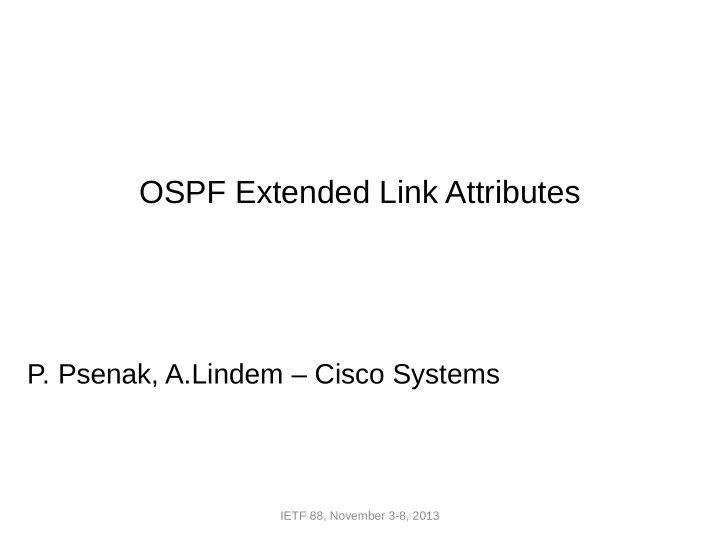

OSPF Extended Link Attributes P. Psenak, A.Lindem – Cisco Systems IETF 88, November 3-8, 2013
OSPF Link Attributes • Many link attributes have been define in OSPF in the context of the MPLS TE and GMPLS • RFC3630, RFC6827, RFC4203, RFC6827, RFC4203, RFC4124, RFC5329, RFC5330, RFC5392, RFC6001, RFC7308, RFC7471 • All these link attributes are advertised in the sub-TLVs of TE Link TLV of Traffic Engineering LSA (RFC3630) IETF 88, November 3-8, 2013
TE Opaque LSA • RFC 3630 – “The extensions provide a way of describing the traffic engineering topology (including bandwidth and administrative constraints) and distributing this information within a given OSPF area. This topology does not necessarily match the regular routed topology” • A link described in TE Opaque LSA becomes part of the TE topology
Extended Link LSA • draft-ietf-ospf-prefix-link-attr-06.txt – “OSPFv2 Extended Link Opaque LSA - allows advertisement of additional attributes for links advertised in Router-LSAs.” • Generic container for advertising link specific attributes
Link Attributes Usage • Some of the link attributes defined for MPLS TE and GMPLS are useful outside of TE/GMPLS • Examples: – Remote interface IP address, Link Local/Remote Identifiers ● Improved two way connectivity check ● SR traffic engineering – Shared Risk Link Group ● LFA – Unidirectional Link Delay, Unidirectional Available Bandwidth ● Path Computation
Link Attributes Advertisement • How do we advertise link attributes originally defined for TE/GMPLS if the usage is outside of TE/GMPLS • Option 1: – Use TE Opaque LSA • Option 2: – Use the Extended Link LSA and define code- points for the existing link attributes
Option 1 – TE Opaque LSA • Advantages: – every link attribute is only advertised once in a single LSA - no duplication of data possible – no additional standardization requirement
Option 1 – TE Opaque LSA (cont.) • Disadvantages: – Link becomes part of the TE topology, even though TE is not enabled on it ● Problem with backward compatibility (RFC3630) – TE Opaque LSA could carry data that is not used by TE. There is no mechanism to indicate which attribute is to be passed to TE and which one not – Link attributes used for non-TE purposes spread across multiple LSA (i.e. Adj-SID is advertised in ELL)
Option 2 – Extended Link LSA • Use exiting format of the TE link attributes • Allocate code points from the OSPF Extended Link TLV Sub-TLV Registry – Defined in draft-ietf-ospf-prefix-link-attr • Code pints allocated on a case by case bases together with the use-case
Option 2 – Extended Link LSA (cont.) • Advantages: – Advertisement does not make the link part of the TE topology – TE Opaque LSA keeps to be truly opaque to OSPF. Its content is not inspected by OSPF, it is passed to TE. OSPF acts as a pure transport. – Clear distinction between TE and IGP data. It avoids any conflicts and is fully compatible with the RFC3630. – All link attributes that are used by IGPs are advertised inside the single LSA (Extended Link LSA)
Option 2 – Extended Link LSA (cont.) • Disadvantages – in rare case, the same link attribute can be advertised in both the TE Opaque and Extended Link Attribute LSAs – additional standardization effort ● advantage - non-TE use cases for the TE link attributes are documented and validated by the OSPF working group
Proposal • Proposal is to use Option 2 • Keep TE Opaque LSA to be used for TE only purposes • For those link attributes defined for TE originally that are useful outside of TE – keep the existing format – allocate new code-point from the OSPF Extended Link Opaque LSA TLVs IANA registry
Next Steps • Looking for the input from the OSPF WG
Recommend
More recommend